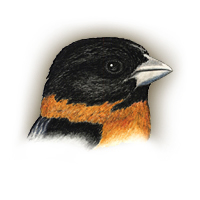 |
Black-headed Grosbeak
Pheuclicus melanocephalus |
|
|
STANFORD LOCATIONS: Uncommon migrant in various habitats throughout campus, most common near the Dish where it breeds in small numbers in wooded areas. |
 |
Location |
Type |
Mating System |
Parental Care |
2ndary Diet |
Strategy |
|
|
|
|
I: 12-13 DAYS ALTRICIAL |
|
|
|
4 feet - 12 feet |
|
(2-5) MONOG |
MF |
FRUIT |
| BREEDING: | Riparian woodland and thickets, edges of ponds, open woodland. 1? brood. |
| DISPLAYS: | Courting male performs song-flights above female with his wings and tail spread while singing nearly continuously, then returns to original perch. Song-flights also occur during incubation. |
| NEST: | Bulky, loosely built of twigs, plant stems, rootlets, lined with finer stems and rootlets. Built in 3-4 days. |
| EGGS: | Pale green, blue, or bluish-green, marked with browns or purples, esp at larger end. 1.0" (25 mm). |
| DIET: | Includes spiders, occ buds. |
| CONSERVATION: | Winters s through Mexico to Oaxaca and Veracruz. Uncommon cowbird host. |
| NOTES: | Both sexes occ sing on nest and are difficult to flush from nest; female songs less complex, more variable than male songs. Female very aggressive in defending territory against other Black-headed Grosbeaks. Both sexes brood. Young able to fly at ca. 15 days; may recognize parents' songs. |
| ESSAYS: | Great Plains Hybrids; Decline of Eastern Songbirds; Bills; Territoriality. |
| REFERENCES: | Kroodsma, 1974; Ritchison, 1983, 1985. |
| Help | Abbreviations | Species-Alphabetical | Species-Taxonomic | Essays-Alphabetical | |
| Except for Stanford Locations, the material in this species treatment is taken, with permission, from The Birder's Handbook (Paul Ehrlich, David Dobkin, & Darryl Wheye, Simon & Schuster, NY. 1988). | |||||